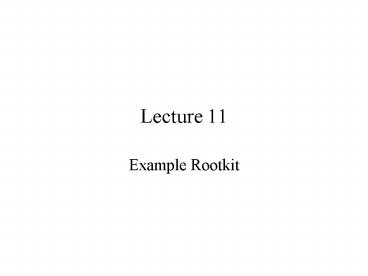Example Rootkit - PowerPoint PPT Presentation
1 / 28
Title:
Example Rootkit
Description:
In Ollydbg, search for all referenced text strings. Not much shown due to ... Unpacks code to kernel memory. Move unpacked code over packed code area ... – PowerPoint PPT presentation
Number of Views:188
Avg rating:3.0/5.0
Title: Example Rootkit
1
Lecture 11
- Example Rootkit
2
Intel internship
- Intel CTG (Corporate Technology Group)
- Advanced research development
- System integrity services using AMT
- Detecting rootkits
- C programming experience
- Low-level OS knowledge
- Embedded programming
- Who can I send?
3
Rustock.B rootkit
- Frank Boldewin, A Journey to the Center of the
Rustock.B Rootkit, Jan. 20, 2007 - http//reconstructer.org
- Combines a number of obfuscation techniques found
in other malware
4
Stage 1 Ollydbg
- Drop from Mother Ship
- Gives you rustock.exe, a Windows PE
- Step 1
- In Ollydbg, search for all referenced text
strings - Not much shown due to obfuscation/packing
- Use PEID or Protection-ID tools to determine
packer/compiler/protector - Not much shown, perhaps a proprietary packer used
- Check for unrecognized data in code
- Code loaded at virtual address of 0x400000
- Entry point of Rustock.B at 0x401000
5
Stage 1 Ollydbg
- Looks like obfuscated code at 0x401B82
- Find references to this address
6
Stage 1 Ollydbg
- At 0x040198D
- PUSH of 0x401B82 followed by RETN
- Same as a CALL
- Set breakpoint and run
- Obfuscated code should be unobfuscated now
7
Stage 1 Ollydbg
- Not quite, have Ollydbg analyze code
- Step through API importing code to obtain API
names for subsequent call instructions
8
Stage 1 Ollydbg
- Find call to kernel32._lcreat
- Creates a file called lzx32.sys (kernel mode
driver) - Set breakpoint and run again
- Select EDI in Registers window and follow it
9
Stage 1 Ollydbg
- EDI points to C\windows\system32lzx32.sys
- Use of instead of \
- Alternative Data Stream (ADS)
- Hides the driver from easy detection
- Windows Explorer and cmd.exe do not show ADS
- Change memory to replace (0x3a) to a \
(0x5c) - Attach ADS to directory since ADS viewers do not
show this - Rerun code and step through driver creation
- Stop code at lclose at address 0x401cc7
- Driver has been deobfuscated and unpacked now
10
Stage 2 PE-Tools
- Driver now detached
- Analyze it in IDA to find obfuscated code
- Detached driver code and .idb file in stage1
directory - Attempt to load in Ollydbg
- Launch using LOADDLL.EXE fails
11
Stage 2 PE-Tools
- Change driver
- Currently a DLL, a native executable, and
contains imports from kernel libraries
(NTOSKRNL.EXE and HAL.DLL) - Change to no DLL, a Windows GUI application, and
no imports - Fix PE-files using PE-Tools
- Unmark DLL bit in PE-Tools
12
Stage 2 PE-Tools
- Change driver
- In Optional Header of PE-Tools, change Subsystem
value from 1 to 2 (Windows GUI)
13
Stage 2 PE-Tools
- Change driver
- Set RVA and size to 0
- Will be reset later
14
Stage 2 Ollydbg
- Driver loads now
- Same as Stage 1 obfuscated code at 0x116a4
15
Stage 2 Ollydbg
- Find references to this address 0x116a4
16
Stage 2 Ollydbg
- Two places with PUSH 0x116a4/RETN
- Set breakpoint and run
17
Stage 2 Ollydbg
- Analyze code now
18
Stage 2 Ollydbg
19
Stage 2 Ollydbg
- Dump debugged process
20
Stage 2 Ollydbg
- Dump debugged process
- Unmark Rebuild Import
21
Stage 2
- After dump, restore PE-File settings
- DLL bit
- Subsystem native
- RVA and Size of Import directory field
22
Stage 3 IDA
- Load dumped file into IDA
23
Stage 3 IDA
- Obfuscated data
- Can not use the previous approach
24
Stage 3
- Read code at 0x116a4
- Import APIs from NTOSKRNL
- Query system modules running
- Allocate kernel memory
- Unpack routine (0x11788)
- Unpacks code to kernel memory
- Move unpacked code over packed code area
- Grab imports from NTOSKRNL and HAL.DLL, destroy
PE-Header, rebase API calls - Free unused kernel memory
- JMP EAX at address 0x117c8
- Real driver created dynamically
- Must rip the unpacking code at 0x117d3 and dump
whole data as file before PE-Header destroyed and
driver code rebased
25
Stage 3
- Program included
26
Stage 3 Reversing Rustock.B
- http//www.sarc.com/avcenter/venc/data/backdoor.ru
stock.b.htmltechnicaldetails
27
Doing it faster with a kernel debugger
- SoftICEICEEXT
- Special function in NTOSKRNL.EXE to load driver
- IopLoadDriver
- Is not exported by default
- Need proper .pdb file of NTOSKRNL.EXE from
Microsoft server - Need to convert it to SoftICE format .nms
- Problem SoftICE symbol retriever unreliable
- Read Frank Boldewins SoftICE howto
- http//reconstructer.org
- Alternative
- Leech Windows Debugging Tools from MSFT
- Read paper for recipe
28
Cleanup
- Run RkUnhooker































